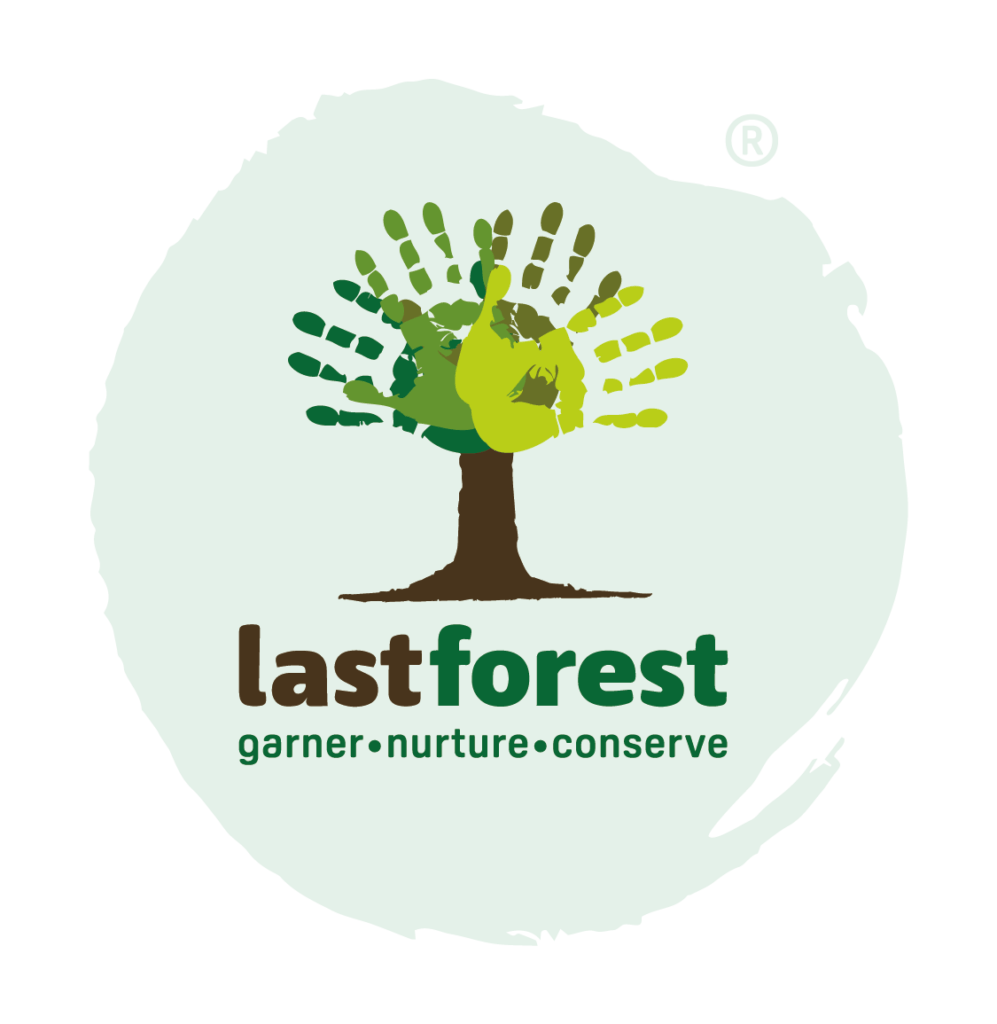honey
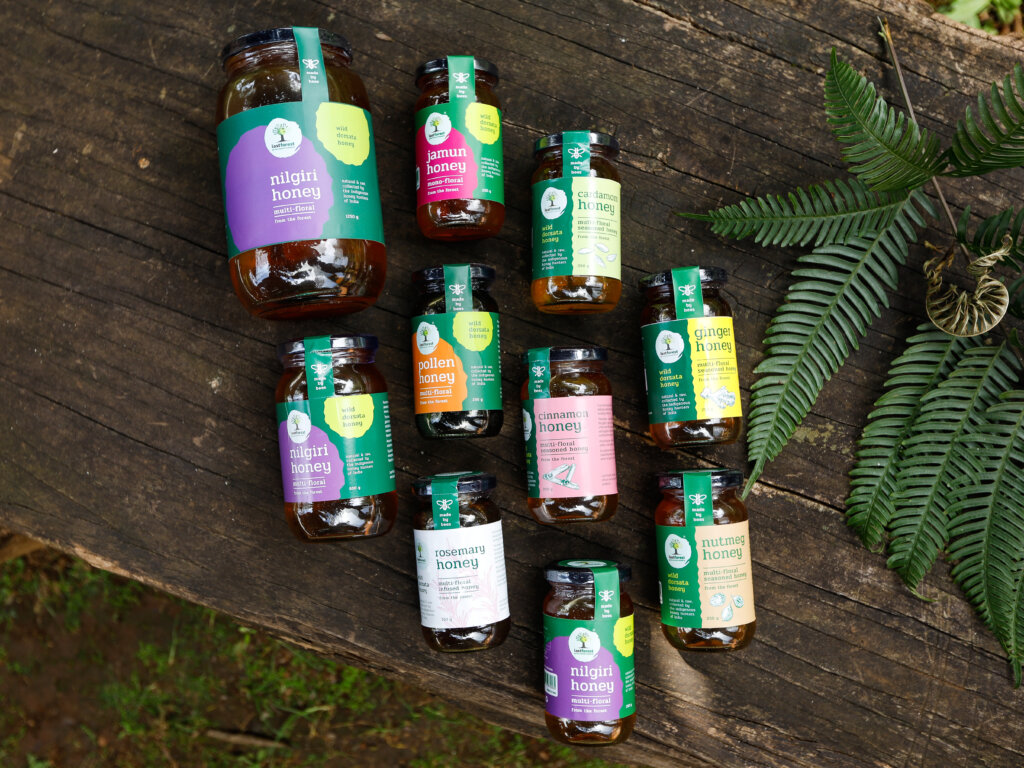
Honey has been used as medicine for over 5,000 years. It is linked to wound-healing properties, antibacterial action, curing cough and cold and fighting infections!
Honey can replace sugar in meals, providing a healthier option. Raw honey is considered to be nature’s sweet superfood due to its numerous health benefits and uses.
Honey can be eaten raw, added to baked food, used as a salad dressing or as a sweetener for beverages. Our entire range of honey is harvested from the Apis dorsata bees.
For centuries, communities in the evergreen forest slopes of the Nilgiris Biosphere Reserve have sustainably harvested this ‘Food of the Gods’, using age old methods of honey hunting for generations!
Last Forest works closely with these communities to source this wild honey from the cliffs of the mountains. This honey is then carefully refined and bottled in eco-friendly packaging to be sold across the world!

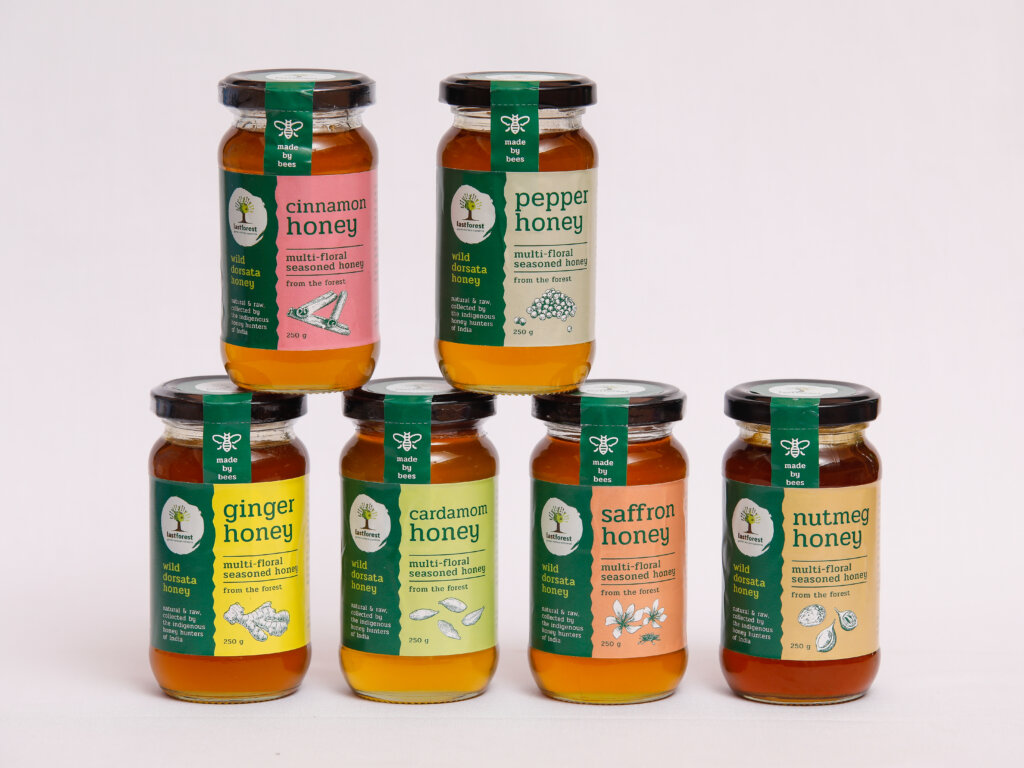
Last Forest’s range of natural honey contains honey that is naturally sweet, a unique bottle of honey that is naturally bitter in taste and a goldmine of health benefits with extra pollen!
We also have a range of flavoured honey, which is the same wild, natural honey that has been infused with natural spice extracts. This range not only leaves a long-lasting taste on your palate, keeping you wanting more, but the added health benefits of infused herbs and spices help build your body’s natural defense against pathogens!
FAQs about honey
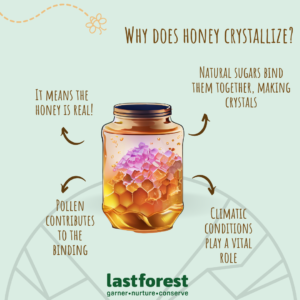 You will notice that sometimes your honey will become thicker and/or cloudy, and a coarse sugary texture forms on the bottle. The crystallization of honey can take place due to the involvement of various factors and is a completely normal and unalarming phenomena. Real, untampered, and natural honey has glucose and fructose present inside of it, these bind together and form the little crystals resulting in harder honey.
You will notice that sometimes your honey will become thicker and/or cloudy, and a coarse sugary texture forms on the bottle. The crystallization of honey can take place due to the involvement of various factors and is a completely normal and unalarming phenomena. Real, untampered, and natural honey has glucose and fructose present inside of it, these bind together and form the little crystals resulting in harder honey.
The crystallization process is natural and has little to no effect on the honey other than new textures, densities, and colouring. Crystallised honey is perfectly safe for consumption and certainly does not mean that it has gone bad. Nutritionally, there is nothing wrong with crystallized honey. However, after honey crystallizes, it becomes highly viscous, making it difficult to remove from its container and challenging to work with.
Each flower species has a different proportion of glucose to fructose in its nectar, and glucose crystallizes more readily than fructose, making the ratio of glucose to fructose in honey an important factor to consider. Honey essentially is made up of 70 percent Sugar and 20 percent of water, and the other 10 percent are micro-nutrients. Glucose essentially can be understood as sugar and its excess presence makes honey susceptible to crystallisation, whereas the content of fructose is known to be normal in honey.
Usually, honey can also crystallise if the water content in it is above 24/25 percent. During the process of filtration if air bubbles which form are not destroyed, they can stay trapped in the bottles and can further lead to the crystallization of honey. The timeframe for the air bubbles to set in honey is 24 hours. Crystals are more likely to form in colder temperatures and therefore the climate in which the honey is consumed in affects its properties. The remnants of pollen found in honey contribute to the binding process which makes the honey further susceptible to crystallisation, although it is a healthy sign that the honey is pure.
Last Forest prides itself on its honey filtering process which extracts impurities, although in rarer cases honey can crystallise if impurities such as dust particles or wax bits are residing in the honey.
A tip to combat the crystallization of honey: In order to de-crystallize honey, all you need to do is fill a large bowl with warm water and let your honey sit in it until all the crystals dissolve.
A tip to embrace the crystallization of honey: By using the hard crystallized honey to your advantage, you can spread it on breads, biscuits or other goodies like a jam or marmalade.
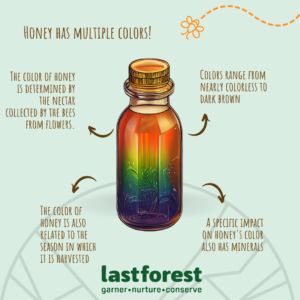 Honey often exists in different colours and shades ranging from light to dark. The colour is determined by the flowers the bees forage on, and the nectar collected by them, in the case of darker honey the nectar collected by the bees from flowering plants directly affects its appearance. Darker honey is rich in mineral content such as iron, potassium, and magnesium. Although the colour of the honey does not indicate its quality but rather speaks to its unique properties.
Honey often exists in different colours and shades ranging from light to dark. The colour is determined by the flowers the bees forage on, and the nectar collected by them, in the case of darker honey the nectar collected by the bees from flowering plants directly affects its appearance. Darker honey is rich in mineral content such as iron, potassium, and magnesium. Although the colour of the honey does not indicate its quality but rather speaks to its unique properties.
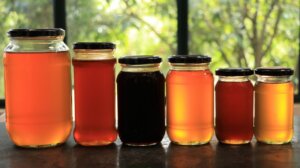
While the essence of the honey is retained and remains similar there are possibilities of the honey tasting/ appearing slightly differently each time you make a purchase. This is often characterised by different factors such as :
the area or location of collection, as honey is often harvested from various regions resulting in ranges of honey;
the flowering species that produce the pollen and nectar which do not necessarily follow the same patterns every time. The honey collection season differs every year as the flowering species differ and it is vital that the honey hunters acclimatise themselves to it;
the climate whether sunny or rainy can impact the honey and perhaps affects the way it tastes or looks. The honey from bio-geographical origins differs, resulting in heterogenous kinds of honey.
The honey season is primarily known to be between the months of April and May, beginning in April and coming to an end by early June.
Last Forest honey is as natural as it can get, as it is sustainably procured and collected from wild honeycombs situated in different regions of the Nilgiris.
Last Forest honey is 100% pure and unadulterated, while it is unprocessed it does undergo the process of filtration which destroys all impurities.
Bitter honey is a variety of honey with a mild bitter taste greeting your palate whenever consumed. It acquires its bitterness as a by-product of the foraging of bees, some bees forage on jamun fruits and land on different flowers, leaving behind the jamun residue on the pollen. This further results in a natural infusion of jamun in honey. The bottle represents the diversity and richness of the Nilgiris Biosphere Reserve.
The bitter honey and jamun honey are one and the same, although over the last few years some of our products have undergone a re-naming process.
Our honey collection processes are extremely sustainable and do not harm the environment, and the smoking process is temporary and does not affect the lifespan of bees but rather helps them escape the hives during the time of collection.
All the honeycombs available in a particular region are not all harvested but rather only the mature ones are used for extraction of honey and beeswax. Every year, a few hives are left untouched so the bees can repopulate it and keep the delicate design of nature in balance.
The misconception that bees are harmed through the process of honey hunting is far from the truth, and often needs to be justified.
Honey as a consumable product has multiple health benefits and medicinal properties. These include aiding the nursing of wounds and burns, improving heart health, building immunity through nutrient content and is an overall traditional remedy adopted by indigenous communities to treat many aliments.
The health benefits for different types of honey are listed below:
Nilgiri Sweet Honey: This healthy delicacy has been used by Indigenous communities for centuries to prevent cough and cold while building immunity.
Pollen Honey: This honey is naturally rich in pollen, which is believed to have a multitude of benefits including for allergies, heart, and liver function.
Jamun Honey: Naturally bitter in taste, this wild honey is sourced from bees that feed on flowers of the Black Jamun (Syzigium cumini) tree. It is believed that the bees impart the benefits of jamun, such as blood sugar regulation, into this honey.
Cinnamon Honey: Cinnamon is believed to have antiviral, antibacterial, and pain relief properties.
Ginger Honey: Ginger is believed to address indigestion, throat ache, nausea, or migraines.
Nutmeg Honey: Nutmeg is believed to have pain relieving and detoxification properties and is traditionally used to aid digestion.
Thyme Honey: This wild honey is infused with homegrown thyme, an herb believed to be rich in vitamins C and A, with benefits for stomach, digestion, and mood.
Rosemary Honey: This wild honey is infused with homegrown rosemary, an herb traditionally cherished for its anti-inflammatory properties, improvement of blood circulation, and benefits for hair.
Cardamom Honey: Cardamom is believed to reduce blood pressure, increase circulation, and be rich in antioxidants.
Saffron Honey: Saffron is lauded as a luxury for not only its distinct taste but also its antioxidant properties.
Pepper Honey: Pepper is believed to aid digestion and throat ache.
Last Forest honey is sourced straight out of wild beehives tucked away in forests within neighbouring regions.
The honey is naturally and sustainably collected directly by honey hunters who trudge on tall cliffs in search of suitable extraction sources.
After paying obeisance to the local deity, the men set out into the forest, armed with the tools of their trade – rope, machetes and baskets to collect the honey. They are especially adept at extracting honey from the hives hidden among the cliffs that soar hundreds of feet into the sky. The rope fastened, the designated climber descends into the depths of the cliff, seeking the hives.
Once he finds a rich source of honey, swinging precariously on the rope ladder, he builds a smoker to agitate the bees into abandoning the hive, taking care not to destroy any of the bees. Blinded by smoke and swarmed by angry bees, he extracts the honeycomb and begins his long climb up.
Once the bees have fled the hives temporarily, the honey hunters go on to extract the honey, and beeswax from the combs.

There are many incentives of purchasing wild honey in contrast from regular cultured honey such as it being sustainably collected and sourced from wildflowers.
The scope of foraging for the bees is much larger in comparison to cultured bees, as the areas and locations are widespread and not limited geographically. The advantage of foraging from different wild flowering species is that the pollen content is much higher, and it is found that the nutritional value in wild honey is higher.
Wild honey is known for its medicinal properties as well. The unique nature of wild unprocessed, raw and untampered honey makes it all the more special and rarer, putting it on the forefront of honey types.
Last Forest honey is not officially organically certified but is registered under PGS Wild, an accreditation which primarily caters to wild produce.
We have opted for PGS Wild and not an organic certification because our honey is collected from different regions and farms, who may not necessarily follow organic practices resulting in wild produce harvested from inorganic regions.
Organic certifications are an often a tedious process to acquire, although Last Forest is not certified on paper it is as organic as it can get.
No additional sugar is added to the honey, the quality of the honey produces the extra sweetness in it.
Honey is a multipurpose condiment which can be malleable according to your needs. It has an array of functions ranging from consumable, medicinal, and decoratable uses.
It can be used as a natural sweetener, and spread over breads, dosas, rotis, and idlies as well as in baking and decorative desserts.
It can be applied as a chemically free face pack, hair removal product, and used to nurse cuts and burns.
It has many traditional medicinal uses adopted by Adivasi communities; it has aruvedic properties as well. Honey is an anti-flammatory and antioxidant and is well known to cure colds and sore throats when mixed in concoctions.
Honey is a unique creation and can be used innovatively in whatever way possible and has no ends to its functions.
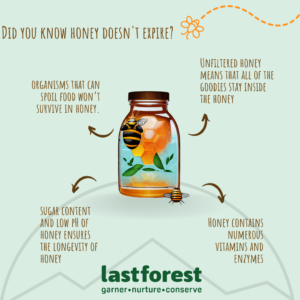 Honey does not expire and can enjoyed for years to come. It does not have an expiry date if it is cared and stored for properly according to instructions. Unfiltered honey ensures that most of the necessary nutrients are retained throughout the period of consumption as honey contains numerous vitamins and enzymes. Most often the organisms which can spoil food do not survive in honey. The magical reason for the longevity of honey lies in its biological make up as the sugar and low pH content constitute its lifespan.
Honey does not expire and can enjoyed for years to come. It does not have an expiry date if it is cared and stored for properly according to instructions. Unfiltered honey ensures that most of the necessary nutrients are retained throughout the period of consumption as honey contains numerous vitamins and enzymes. Most often the organisms which can spoil food do not survive in honey. The magical reason for the longevity of honey lies in its biological make up as the sugar and low pH content constitute its lifespan.
Precautions:
Do not directly refrigerate and heat honey.
Do not use a wet spoon or your finger when taking it out of its bottle.
Do not store honey in a plastic container instead use a glass bottle.
While Last Forest remains on the pricier side in contrast to other honey brands, the cost of the product has been evaluated carefully and deserves the value it stands for.
Last Forest honey is completely natural, unprocessed, raw, wild, unadulterated and sustainably sourced unlike other honeys which may be cheaper due to their cultured and adulterated properties. The pricing has been set after much deliberation and careful consideration as there are many variables affecting its procurement.
The honey is known to be collected from various regions, and therefore requires honey hunters to travel to these collection sites for a reasonable number of days. Logistical, food, daily wage, travel and other such expenses influences the cost.
We must invest in our labelling, procuring, equipment/machinery, marketing and social media, filtration, and other such procedural costs which add up to the total giving our honey its MRP.
As a social enterprise who make profit through the market, we still have the responsibility of relaying back our monetary resources to the communities to ensure sustainability of their livelihoods.
Our honey collection processes are sustainable because they do not damage the environment, beehives, bee colonies, or forests, but instead help in stewarding nature and its resources responsibly and consciously.
Last forest believes in values such as leaving natural habitats better off than when they were first found, and in leaving a sustainable and measurable impact behind.
The process undertaken when collecting honey ensures that it abides by certain boundaries and parameters. Such as the smoking of beehives ensures that bees are kept safe.
Last forest does not externally input any chemicals or impurities into their products especially honey which is collected in its rawest and purest essence. The process of filtration is consciously practised while attempting to retain the honey’s rawest character.
The influence that Last Forest has had on local communities, especially in relation to indigenous women is immeasurable, they have always believed in empowering people through the work they do. This impact is seen as a socially sustainable footprint.
